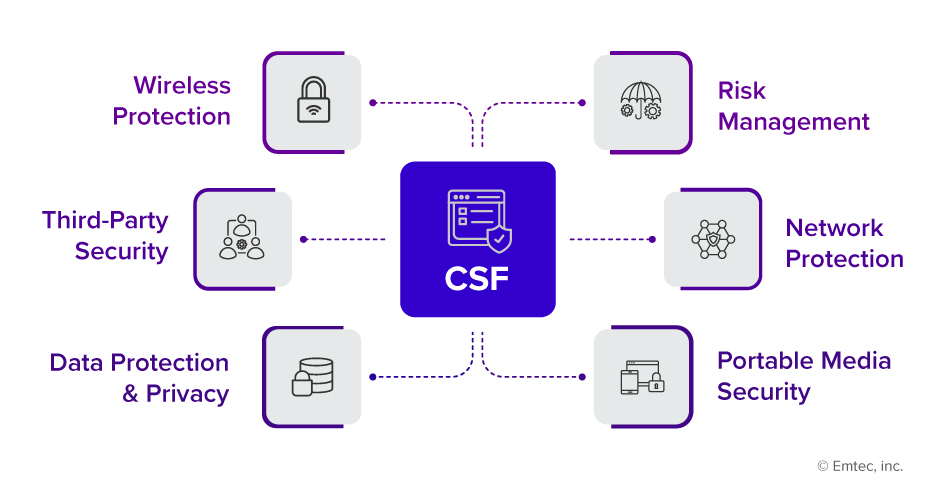HITRUST compliance can deliver undisputed data security, compliance, faster GTM and more! Read on to explore!
Health Information Trust Alliance (HITRUST) was founded in 2007 as a partnership of leaders in healthcare, technology, and information security. Its goal was to develop a unified cyber defense framework for the entire healthcare supply chain. Today, HITRUST offers data protection standards and certification programs which help organizations safeguard sensitive information, handle high levels of data security, and achieve compliance objectives.
HITRUST CSF (Common Security Framework) is the foundation for all services and programs. CSF entails a rigorous assessment procedure, including a third-party audit to assure an organization’s clients, partners, and regulators that it has robust security and privacy controls in place.
Let’s learn what domains are covered by HITRUST CSF:

Why HITRUST Matters to the Healthcare Industry
There have been 2,100 hospital data breaches in the US over the last ten years. – Astra Security
This surprising statistic shows the high risk of malicious attacks that healthcare organizations face. An organization’s security policies and processes will determine the likelihood of an attack actually succeeding.
In any business, preventing data breaches necessitates a complex combination of microtasks. These can include everything from network patching to updating security policies. However, an organized risk management program at the macro level is critical to ensure comprehensive data security. HITRUST aids healthcare organizations in preventing data breaches by providing guidance on how to implement the appropriate policies, and procedures, and enhance them over time.
- HITRUST framework is the most widely adopted framework for healthcare security in the United States. It provides an industry-wide strategy for business associate compliance management.
- Regular updates to HITRUST ensure that healthcare organizations utilizing the framework are prepared for new regulations and security risks.
The average cost of a data breach in 2021 was $4.24 million per incident, up 10% from the previous year.
Also, the cost per lost or stolen record containing sensitive and confidential information increased from $150 in 2020 to $174 in 2021. – IBM Security
HITRUST Beyond Healthcare – Other Industries Adopting the Trend
Security frameworks like HITRUST simplify the process for organizations to achieve stringent compliance to guarantee safety of sensitive data. The scope of HITRUST continues to grow with firms in additional industries implementing HITRUST to manage information security risks and protect sensitive data. Here are some examples use cases for a few different industries:
- Finance: Financial institutions manage exceedingly sensitive data, including personally identifiable information (PII) and financial data. HITRUST can be used to manage information security risks, protect customer data, and comply with regulatory requirements such as the Gramm-Leach-Bliley Act (GLBA). This federal law was enacted in the United States in 1999 to address concerns about consumer financial information privacy and security.
- Government: HITRUST can also be used by government agencies to protect sensitive data, including classified information. HITRUST certification can help government agencies demonstrate compliance with Federal Information Security Management Act (FISMA) requirements.
- Retail: Retailers also handle sensitive customer data, including personally identifiable information (PII) and credit/debit card information. HITRUST can be used to manage information security risks, protect customer data, and comply with industry regulations such as the Payment Card Industry Data Security Standard (PCI DSS).
- Technology: Technology companies that develop software and provide cloud services also handle sensitive data, including customer data and intellectual property (IP). HITRUST can be used to manage information security risks, protect sensitive data, and comply with industry regulations such as the General Data Protection Regulation (GDPR) and the California Consumer Privacy Act (CCPA).
- Life Sciences: The life sciences industry faces unique security and compliance challenges related to the storage, processing, and sharing of sensitive data such as clinical trial data and patient health information. The HITRUST framework can help life sciences organizations implement a comprehensive security and compliance program that addresses these challenges and helps them meet regulatory requirements.
- Insurance: The insurance industry deals with sensitive data such as customer financial information, which makes it an ideal target for cyber criminals.
HITRUST can help insurance organizations implement a comprehensive security and compliance program that addresses these challenges and helps them meet regulatory requirements such as the National Association of Insurance Commissioners (NAIC) model law on cybersecurity.
- Hospitality Sector: The hospitality industry also faces security and compliance challenges related to storing guest personal data including data related to requested hospitality services. HITRUST can help hospitality organizations implement a comprehensive security and compliance program that addresses these challenges and helps them meet regulatory requirements.
HITRUST is quickly gaining popularity in a wide range of industries to manage information security risk and protect sensitive data.
Benefits of using HITRUST
With so much at stake, what are the benefits of utilizing the HITRUST framework? Let’s discuss the top 4 benefits of using HITRUST now:
- Applicable to Different Organizations: HITRUST is a risk and compliance-based framework. Organizations can customize the security and privacy control baselines in HITRUST according to the organization’s type, IT environment, and any relevant regulatory requirements. With a well-known framework and tested assessment methodology, it directs the adoption of stronger data security and information risk management practices across all industries.
- More Efficient Compliance Process: HITRUST is a system that can be certified and offers businesses an effective method for managing risk and complying with regulations. It combines pertinent laws and standards into a single overarching security and privacy framework. This has been created in cooperation with IT security experts from various fields to ensure an efficient compliance process.
- Third-party Risk Management: Organizations can improve vendor relationships by demonstrating their dedication to security by using HITRUST applications. It offers a clear and consistent risk management framework to help you compare other businesses’ internal and external organizations to your organization’s cybersecurity program.
- Commitment to Security: Through HITRUST, your company can demonstrate its commitment to data security and a forward-thinking approach. Internal and external stakeholders are more confident in organizational management and its capacity to handle industry-specific standards with an industry-standard solution is in place.
HITRUST vs. HIPAA
People often get confused between the HITRUST and HIPAA frameworks. For better understanding, we have drawn a comparison between both:
| Parameters | HITRUST | HIPAA |
| Definition | A framework developed by industry experts to manage information security risks within organizations. | Federal law that sets the standard for protecting sensitive patient data. |
| Purpose | Provides a more rigorous set of controls that can help organizations manage their overall information security risk more effectively. | HIPAA provides a set of regulations to protect the privacy and security of individually identifiable health information. |
| Scope | HITRUST covers a broad range of security and privacy controls across various industries, including HIPAA. | HIPAA primarily applies to covered entities, such as healthcare providers, health plans, and clearinghouses, and their business associates. |
| Framework | HITRUST CSF incorporates various industry regulations and standards, including HIPAA, NIST, PCI DSS, and others, into a single, comprehensive framework. | HIPAA Security Rule requires covered entities to implement certain administrative, physical, and technical safeguards to protect PHI. |
| Compliance Requirements | HITRUST includes multiple security and privacy regulations, including HIPAA, and requires organizations to implement controls across 19 domains. | HIPAA requires covered entities to implement specific administrative, physical, and technical safeguards to protect PHI. |
| Penalties for Non-Compliance | HITRUST does not have specific penalties for non-compliance, but non-compliance can impact an organization’s ability to do business with partners and customers. | HIPAA violations can result in significant fines and penalties, ranging from $100 to $50,000 per violation, depending on the severity of the violation. |
HIPAA and HITRUST share a common goal of protecting sensitive health information, but HITRUST has an edge over HIPAA in providing a comprehensive and standardized approach to managing information security risks.
Challenges that HITRUST can Solve
Some business challenges that HITRUST can help solve include:
- Regulatory Compliance: Organizations are subjected to a variety of regulatory requirements, like in healthcare, finance, hospitality, and many more. HITRUST can help these sectors meet compliance requirements by providing a comprehensive framework that integrates all relevant standards and regulations.
For example:
Financial institutions use the HITRUST framework to comply with regulatory requirements such as the New York Department of Financial Services (NYDFS). This regulation requires banks, insurance companies, and other financial services companies to implement and maintain cybersecurity programs that include risk assessments, written policies and procedures, and employee training.
By using the HITRUST framework and associated apps, financial institutions can identify and remediate security risks, improve their security posture, and demonstrate compliance with regulatory requirements.
- Third-party Risk Management: Organizations rely on third-party vendors to provide services and solutions, such as customer records and cloud hosting. HITRUST provides a standardized approach to assessing and managing the security risks of third-party vendors.
- Data Breach Prevention and Response: Customer centric organizations are a prime target for data breaches due to the sensitive nature of the data they store. HITRUST provides a risk-based approach to identifying and mitigating security risks that could lead to data breaches, as well as a standardized approach to incident response and breach notification.
- Vendor Management: Various organizations often work with third-party vendors to provide services such as IT support, consulting, marketing, and other functions. HITRUST provides a standardized approach to vendor management, helping organizations assess and manage the risk associated with third-party vendors.
Pros and Cons of HITRUST
| Pros | Cons |
| Comprehensive Framework
HITRUST provides a comprehensive approach to managing and securing sensitive data, covering a wide range of information security and privacy requirements. |
Cost
HITRUST implementation can be costly, particularly for smaller organizations with limited budgets. The implementation process requires significant resources, including time, personnel, and technology. |
| Third-Party Validation
HITRUST certification provides third-party validation that an organization has implemented effective security controls and safeguards. This certification can help demonstrate to customers, partners, and regulators that the organization takes data security seriously and is committed to protecting sensitive information. |
Time-Consuming
Implementing HITRUST can be a time-consuming process as it requires changing existing business processes and workflows. Depending on the size and complexity of the organization, the process can take months to complete. The framework consists of numerous domains, each with multiple control objectives, and implementation requirements. Each domain requires extensive documentation, assessment, and testing, which can be time-consuming. |
| Increased Security and Reliability
HITRUST provides a comprehensive approach to managing and securing sensitive data, covering a wide range of information security and privacy requirements. |
Why Should Your Organization adopt HITRUST?
The short answer to why organizations should adopt HITRUST is because it is comprehensive, highly reliable, and rigorous.
As digital information technology becomes increasingly common, organizations are increasingly vulnerable to cyberattacks and breaches. Any organization that needs to address compliance and risk management can benefit from achieving HITRUST compliance. Have a look at few of the reasons to adopt HITRUST:
- Transparency: Internal and external stakeholders need to have a clear understanding of your organization’s compliance framework. The HITRUST framework is publicly accessible and widely adopted, and each release’s updates are exhaustively documented.
- Accuracy: Numerous other frameworks are qualitative, judgment-based, and lack quantitative measurements. While HITRUST precisely evaluates, identifies flaws, and ranks security & privacy controls. In addition, HITRUST uses a five-point PRISMA-based maturity model and compares each maturity level to a compliance scale ranging from non-compliant to fully compliant.
- Consistency: When frameworks are unclear, subjective, or lack maturity levels and scoring methodologies, it becomes challenging to evaluate an organization’s position at that level. The problem is worsened when assessment activities are not subject to quality and integrity assessments by an independent third-party assessor. HITRUST ensures that each control is documented, analyzed, verified, and validated to address the issue.
- Integrity: The integrity of your assessment results and assurances to internal and external stakeholders depends on an audit and validation procedure. By appropriately validating the framework’s security controls, HITRUST ensures that the assessment and certification process is trustworthy.
- Scalability: HITRUST provides a scalable framework for implementing and managing security controls and compliance requirements for applications. The framework is designed to support organizations of all sizes, and it can be customized to align with specific business needs and requirements. HITRUST ensures that the scalability and effectiveness of the security controls is implemented.
- Faster GTM (Go-To-Market): HITRUST certified applications can leverage automation to accelerate the implementation process and reduce the time to market. HITRUST provides automation tools such as security information and event management (SIEM) systems, and configuration management tools. These automation tools can help reduce the manual effort required to implement and manage security controls, thus enabling faster GTM.
- Speed to Market: By adopting the HITRUST framework, organizations can demonstrate their commitment to data security and compliance, which can help build trust with customers and business partners. HITRUST also provides a standardized approach to compliance, which can help reduce the time and effort required to meet regulatory requirements. This can lead to a faster time to market for new products or services.
- Higher TAT: HITRUST certified applications can provide higher turnaround times (TAT) by streamlining compliance processes and reducing the risk of security breaches or data mishandling. Overall, HITRUST can be a crucial factor in helping companies improve their security posture and streamline compliance processes.
Is it Worth to Invest in HITRUST?
This is a frequently asked question by small and medium-sized enterprises. How much does it cost? It is a significant and valid concern.
But if we see HITRUST as a medium- to long-term investment, and an ongoing process of improvement rather than a one-time expense, you gain a different perspective. Instead of inquiring how much the HITRUST framework will cost, ask “what will we gain in return for our investment?”
Investing in a robust, comprehensive risk management program is necessary to achieve HITRUST compliance. It requires the creation of solid policies and procedures and their effective implementation. It also involves eliminating the duplication of fundamental steps mandated by multiple regulatory standards. It necessitates the need to collaborate with competent, and well-trained evaluators.
Bridgenext – Your Compliance Success Partner
In today’s fast pacing environment, organizations rely heavily on a solid and agile security posture. Brdgenext can assist you in adopting the HITRUST framework. Whether it’s a first-time implementation, or you are looking to enhance your capabilities, our team of experts will guide you in every step.
Ready to take the next step in your HITRUST compliance journey?
Contact us now to learn how we can guide you through the process in the most cost-optimized manner.
References
www.getastra.com/blog/security-audit/healthcare-data-breach-statistics/
www.ibm.com/downloads/cas/OJDVQGRY
www.rsisecurity.com/compliance-advisory-services/nydfs-23nycrr500/



